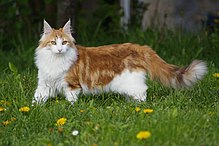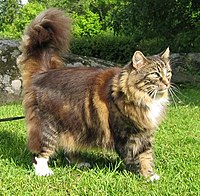Norwegian Forest cat
| Norwegian Forest cat | |
|---|---|
 Amber blotched tabby and white female | |
| Common nicknames | skogkatt |
| Origin | |
| Breed standards | |
| CFA | standard |
| FIFe | standard |
| TICA | standard |
| WCF | standard |
| ACF | standard |
| ACFA/CAA | standard |
| CCA-AFC | standard |
| GCCF | standard |
| Domestic cat (Felis catus) | |
The Norwegian Forest cat (
During World War II, the Norwegian Forest cat was nearly extinct; then the Norwegian Forest Cat Club's breeding program increased the cat's number. It was registered as a breed with the European Fédération Internationale Féline in the 1970s, when a cat fancier, Carl-Fredrik Nordane, took notice of the breed and made efforts to register it. The breed is very popular in Norway, Denmark, Sweden, Iceland, and France.
It is a large breed with a strong body, similar to the Siberian and Maine Coon cat breeds, with long legs, a bushy tail, and a sturdy body. It is very good at climbing, partly because of strong claws.
History

The Norwegian Forest cat is adapted to survive
Norse legends refer to the skogkatt as a "mountain-dwelling fairy cat with an ability to climb sheer rock faces that other cats could not manage."[7] Since the Norwegian Forest cat is a very adept climber,[8][9] author Claire Bessant believes that the skogkatt folktale could be about the ancestor of the modern Norwegian Forest breed.[7] The name Norse skogkatt is used by some breeders and fancier organisations for the modern breed.
The ancestors of the Norwegian Forest cat most likely served as

In 1938 the first organisation devoted to the breed, the Norwegian Forest Cat Club, was formed in Oslo, Norway.[13] The club's movement to preserve the breed was interrupted by World War II. Owing to cross-breeding with free-ranging domestic cats during the war, the Norwegian Forest cat became endangered and nearly extinct until the Norwegian Forest Cat Club helped the breed make a comeback by developing an official breeding program.[14][15]
In the 1950s,
The Norwegian Forest breed is very popular in Norway and Sweden. Since 2003, it has been the fifth most popular cat breed in France, where there are about 400 to 500 births per year.[20][21][22]
Description
Appearance
The Norwegian Forest cat is strongly built and larger than an average cat. Adult females weigh 3.6–8 kg (7.9–17.6 lb); males, 4.5–9 kg (9.9–19.8 lb). The breed has a long, sturdy body; long legs; and a bushy tail. The coat consists of a long, thick, glossy, water-repellent top layer and a woolly undercoat and is thickest at the legs, chest, and head.[7] The undercoat appears as a ruff. The profile of the breed is generally straight.[10] Their water-resistant coat with a dense undercoat developed to help the cat survive in the harsh Scandinavian climate.[23]
The head is long with an overall shape similar to an equilateral triangle, a strong chin, and a muzzle of medium length; a square or round-shaped head is considered to be a defect.[24] The eyes are almond shaped and oblique, and may be of any colour.[7][25] The ears are large, wide at the base, and high set, have a tufted top, are placed in the extension of the triangle formed by the head, and end with a tuft of hair like the ears of the lynx.[24]
All coat colours and divisions in the traditional, sepia and mink categories are accepted.[24] Since the cats have very strong claws, they are very good climbers, and can even climb rocks.[17]
Behaviour

They are friendly, intelligent, and generally good with people.[4] The Norwegian Forest cat has a lot of energy.[4] Fanciers note that these cats produce a variety of high-pitched "chirping" vocalisations.[citation needed]
Norwegian Forest cats that live primarily outdoors become swift and effective hunters, but the breed can also adapt to indoor life.[6]
A study comparing Norwegian Forest cat kittens to
Health
In an experiment directed by John C. Fyfea, Rebeccah L. Kurzhals, and others, it was concluded that a complex rearrangement in the breed's Glycogen branching enzyme (GBE1) can cause both a perinatal hypoglycemic collapse and a late-juvenile-onset neuromuscular degeneration in glycogen storage disease type IV in the breed.[27][28] This disorder, while rare, can prove fatal to cats that have it.[4] Glycogen storage disease type IV due to branching enzyme deficiency was found in an inbred family of Norwegian forest cats.[29]
The breed has also been known to suffer from hip dysplasia,[30] which is a rare, partially hereditary disease of the hip joint.[31]
An analysis of pedigree records of cats in England found evidence of hereditary cardiomyopathy.[32] A study looking at 17 cases of eosinophilic granuloma complex in Norwegian Forest cats found a link between the cats after reviewing pedigree analysis, suggesting a hereditary nature of the condition.[33]
See also
- Maine Coon
- Siberian cat
- Norwegian Elkhound
- Norwegian Lundehund
- Norwegian sheep landrace
- Norwegian chicken landrace
References
- ^ Association, Cat Fanciers. "Breed Profile: The Norwegian Forest Cat". cfa.org. Archived from the original on 21 November 2018. Retrieved 25 September 2017.
- ^ "Accueil - chat norvegien - chat des forets norvegiennes" (in French). Kogkatt-norvegien.org. Archived from the original on 7 December 2014. Retrieved 5 March 2011.
D'un aspect mi-chat, mi-lynx. Contrairement à d'autres races, le "Norvégien" n'est pas le résultat d'une reproduction planifiée mais la conséquence de l'évolution d'un chat placé dans des conditions de survie particulièrement difficiles: le rigoureux climat de la Norvège.
- ISBN 2-03-517402-3.
- ^ ISBN 978-0-8118-1929-9.
- ISBN 978-0-8138-0331-9.
- ^ ISBN 978-0-671-68649-9.
- ^ ISBN 978-0-7641-5203-0.
- ISBN 978-1-902328-00-3.
- ^ "Norwegian Forest Cat Breed Information". Vetstreet. Retrieved 25 September 2017.
- ^ a b "Breed Profile: The Norwegian Forest Cat". Cat Fanciers' Association. Retrieved 10 September 2014.
- ISBN 978-1-59679-267-8.
- ISBN 978-1-4027-5278-0.
- ^ a b "Lost Woods Norwegian Forest Cats". 2009. Retrieved 10 September 2014.
- ISBN 978-0-86101-703-4.
- ISBN 978-0-7506-4069-5.
- ISBN 978-1626861718.
- ^ ISBN 978-1-59253-591-0.
- ^ "Kattförbundet Sverak". Archived from the original on 15 April 2009. (in French). Sverak. Retrieved 20 March 2011.
- ISBN 978-1-876778-75-0.
- ^ "Pour l'Angleterre" (in French). Aniwa.com. Archived from the original on 23 February 2011. Retrieved 5 March 2011.
- ^ "Le Sphynx: Haut dans les cœurs du classement CFA". Aniwa (in French). Retrieved 6 December 2010.
- ^ "Bienvenue sur le site de l'Unité de Médecine de l'Elevage et du Sport de l'Ecole Nationale Vétérinaire d'Alfort". UMES (in French). Archived from the original on 2007-03-06. Retrieved 12 March 2011.
- ^ "Norwegian Forest Breed". tica.org. 13 August 2018. Retrieved 5 February 2020.
- ^ ISBN 978-2-03-517402-4.
- ^ Norwegian Forest Breed Standard Archived 28 July 2011 at the Wayback Machine. The International Cat Association. Published 1 May 2004. Accessed 26 March 2011.
- S2CID 12358514. Retrieved 6 January 2024.
- PMID 17257876.
Deficiency of glycogen branching enzyme (GBE) activity causes glycogen storage disease type IV (GSD IV), an autosomal recessive error of metabolism. Abnormal glycogen accumulates in myocytes, hepatocytes, and neurons, causing variably progressive, benign to lethal organ dysfunctions. A naturally occurring orthologue of human GSD IV was described previously in Norwegian Forest cats (NFC).
- ISBN 978-0-470-09530-0.
- PMID 1337588.
- ISBN 978-0-8065-2436-8.
An example here is the Norwegian Forest cat. Dedicated owners learned that their cats have the possibility of suffering from hip dysplasia.
- ISBN 978-0-312-97288-2.
- S2CID 28958322.
- S2CID 1377327.


